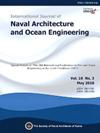An optimization design method for submarine cabins based on intelligent algorithms
IF 3.9
3区 工程技术
Q2 ENGINEERING, MARINE
International Journal of Naval Architecture and Ocean Engineering
Pub Date : 2025-01-01
DOI:10.1016/j.ijnaoe.2024.100642
引用次数: 0
Abstract
Submarine compartment layout design is a multi-objective optimization problem, which needs to consider the mutual position, passage relationship, comfort, convenience, and other aspects between compartments. Based on the characteristics of submarine living cabin layouts, this paper introduces a fuzzy evaluation method to comprehensively analyze the functional adjacency and personnel circulation relationships between compartments. Moreover, combined with emergency evacuation requirements, the study established a double layer cabin layout optimization model and proposed a multi-population genetic algorithm for optimizing the layout of submarine living cabins. Simulation experiments were conducted using MATLAB software to validate the algorithm's effectiveness. A comparison was made between the multi-population genetic algorithm and the standard genetic algorithm. The results verify the feasibility of the proposed design method and its ability to effectively address the submarine compartment layout optimization problem, thereby improving the efficiency of compartment layout optimization design.
基于智能算法的潜艇舱室优化设计方法
潜艇舱室布置设计是一个多目标优化问题,需要考虑舱室之间的相互位置、通道关系、舒适性、方便性等方面。根据潜艇生活舱室布局特点,引入模糊评价方法,综合分析各舱室之间的功能邻接性和人员流动关系。并结合应急疏散需求,建立双层舱室布局优化模型,提出多种群遗传算法优化潜艇生活舱室布局。利用MATLAB软件进行了仿真实验,验证了算法的有效性。将多种群遗传算法与标准遗传算法进行了比较。结果验证了所提设计方法的可行性,能够有效解决潜艇舱室布置优化问题,从而提高舱室布置优化设计的效率。
本文章由计算机程序翻译,如有差异,请以英文原文为准。
求助全文
约1分钟内获得全文
求助全文
来源期刊

International Journal of Naval Architecture and Ocean Engineering
ENGINEERING, MARINE-
CiteScore
4.90
自引率
4.50%
发文量
62
审稿时长
12 months
期刊介绍:
International Journal of Naval Architecture and Ocean Engineering provides a forum for engineers and scientists from a wide range of disciplines to present and discuss various phenomena in the utilization and preservation of ocean environment. Without being limited by the traditional categorization, it is encouraged to present advanced technology development and scientific research, as long as they are aimed for more and better human engagement with ocean environment. Topics include, but not limited to: marine hydrodynamics; structural mechanics; marine propulsion system; design methodology & practice; production technology; system dynamics & control; marine equipment technology; materials science; underwater acoustics; ocean remote sensing; and information technology related to ship and marine systems; ocean energy systems; marine environmental engineering; maritime safety engineering; polar & arctic engineering; coastal & port engineering; subsea engineering; and specialized watercraft engineering.
 求助内容:
求助内容: 应助结果提醒方式:
应助结果提醒方式:


